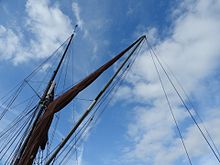Thames sailing barge
The mizzen was a much smaller mast on which was set a single sail whose main purpose was to aid steering when tacking.The barges required no ballast, and sailing in this condition with leeboards raised they typically draw only 3 foot; this has caught out a few modern yachtsmen who have run aground while attempting to follow them.When no wharf was available, the barge could use the ebbing tide to stand on the mud, close to shore and offload its goods onto carts.[5] In good conditions, sailing barges could attain speeds of over 12 knots (22 km/h; 14 mph), and their leeboards allowed them to be highly effective windward performers.There is a print in the Guildhall Library dating from 1764, showing a 1697 built, round bowed barge with a spritsail rig – but with no mizzen.The aim of the founder William Henry Dodd, "The Golden Dustman", was to raise the status of the bargemen, and to improve the performance of the barges.[15] The last Thames barge to trade entirely under sail was the Everard-built SB Cambria in 1970, owned by the folk song collector Captain A. W. (Bob) Roberts.[19] Typically they would run into London laden on a Monday, discharge and return the Thursday with a new cargo to arrive home to spend the Sunday with their families.The mainsail had to be smaller to clear this stack (this could be achieved by reefing), and the foresail would be sheeted to a temporary wire horse.Often the stack would also overlap the sides of the vessel, and in all cases it obscured the view from the helm requiring excellent communication between master and mate sailing such an awkward load in a crowded river.They stowed their leeboard and lowered their gear flat on deck, so their highest point would be the wheel from which spokes would be removed to gain a few extra inches.This was transported by barge, to Teynham, Lower Halstow and Conyer and the finished Kentish yellow bricks went back to London.[23] Portland stone was brought from the quarries at Weymouth round the North Foreland, into the Thames estuary and up into the London River.[33] Coastal barges made long passages, SB Havelock of London built in 1858 used to trade regularly between Liverpool and Rotterdam.The matches are credited with encouraging improvements in design, leading to the craft's highly efficient final form.Dodd was a plough boy from Hackney, London, who made his fortune carrying the city's waste to the country on the barges.[35] The matches have ceased and been reinstituted several times, and are now considered the world's second-oldest sailing race (after the America's Cup).[36] Thirty barges were part of the fleet of 'Little Ships' that rescued soldiers of the retreating British Expeditionary Force from the beaches of Dunkerque.They were built in bargeyards adjacent to a river or creek on bargeblocks- a series of trestles raised about a metre from the compacted ground, that allowed working access above and below.At the bow the stempost was raised vertically and at the stern the sternpost, these were made from 6 feet (1.8 m) lengths of 12 by 9 inches (30 by 23 cm) English oak.The fore and aft deadwood would raise the floors to give shape at the bow and the sweep to the fashion timbers of the transom.On Kathleen the keelson was a made of a 49 feet (15 m) steel section, in profile similar to railway line (6 by 11 inches (15 by 28 cm)):[42] it was cheaper but could distort.The height of the deck was marked on the frames – forming a beam-line, and a beam thickness beneath it, a 15 by 4 inches (38 by 10 cm) oak inwale was bolted to the futtocks.The entire sail can be quickly brailed to the mast, allowing unimpeded access to the deck and hold when loading and unloading.As the sheet is eased, the aft end of a boom would drag in the water, making the rudder ineffective and a capsize inevitable.Vangs control the head of the mainsail and act a sheets for the topsail, which can be set so as to make use of the air above the wind-shadow of moored ships, warehouses and local features.[55] In narrow channels, and in the lee of tall buildings the mainsail and mizzen are brailed and the bowsprit topped up, and she sails on topsail and foresail alone.[56] A boomie is a flat-bottomed ketch-barge, ketch rigged on the main and the mizzen; the sprit was replaced by a gaff, and the foot was tied to a boom.[62] The committee members were Jim Lawrence (chairman), Colin Leggett (treasurer), John Kemp (organizing secretary), and Tom Hawkins.However, the company was unable to make sufficient money from adventure training and they operated Memory as a weekend charter vessel with John Kemp as the skipper.








sailing boatRiver ThamesLondonflat-bottomedbargesleeboardsThames Estuarymainsailbrailedforesailtopsailmizzenanchor windlassRegent'sSurrey canalsEnglandBristol ChannelbrickscementrubbishgunpowderMedwayAmerica's Cupwoodenhulledtransomspritsailriggedultra-violetlamp-blackNorfolk wherriesmast caseChelsea WaterworksFoulness PointunballastedlugsailWilliam Henry DoddFrindsburySB Cambriafolk song collectorCaptain A. W. (Bob) RobertsLeigh-on-SeaTilbury DocksIpswichSecond World WarlighteringLondon BridgePool of Londonhorse and cartmetalled roadsreefingMirosamodel-makersAylesfordStroodRochester BridgeTeynhamCharles RichardsonConyerMiltonSwin (Thames)Puddle DockSB KathleenGravesend, KentRochesterbreezeLower HalstowKentish yellow bricksSittingbourneMargateLiverpoolRotterdamRiver ColneHackneyCharles DickensOur Mutual FriendGravesendGillingham PierMedway buoyLittle ShipsBritish Expeditionary ForceDunkerqueSB PudgeGreat YarmouthBrightlingseaKathleenEnglish oakdeadwoodhalf hull modelOregon pinekeelsonshipwrightpitch pineinwalecarlingswinchesruddertillerworm screwchaff cutterbowspritmain mastmizzen mastspritsailslighterballastedsail twistSB Xylonitebarquentinestaysail bargesbowsprit bargesWalletspinnakerswire ropesforestaywindlassred ochreNorfolk WherryHervey BenhamJohn Kempanti-fouling paintCooks YardRiver BlackwaterLondon Borough of RedbridgeBoard of TradeThalatta